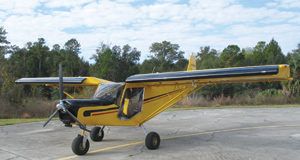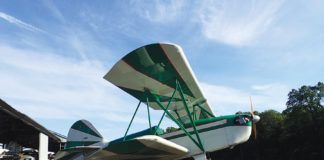Its a beautiful VFR day, and because my daughter had been asking for a ride in the RV-6, my second-born and I are winging our way to Grandmas house for lunch. The 50-minute flight is one I have made several times, and is conducted primarily over flat farmland except for about 20 minutes over a thickly wooded national forest. The portion of the flight over the trees has always captured my attention because of the scarcity of potential landing sites in the remote wilderness, but today my stress meter is running a little lower than on previous trips over this region.
At home, my wife, who reflects on these flights in a special way when one of the children is onboard, occasionally walks to the computer and takes a glance at the monitor. On a detailed map of the terrain between our living room and Grandmas house is a series of red dots connected by a solid line. Every 60 seconds another dot appears, and the line with the little airplane symbol tagged N399SB is extended in the direction of Grandmas airport. Today, she breathes a little easier because she is watching our track in real time as it progresses across the country to our destination.
Grandma and Grandpa likewise are watching their computer draw the same map, and as they see the flight approaching their nearby airport, Grandma makes one more check on the potato casserole warming on the stove, and then they head for the car for the short journey to the airport and a reunion with their favorite granddaughter. This trip has been more enjoyable than usual for them as they watched our plane depart our home airport and fly toward the lunch appointment.
Watch Your Track
How much would it be worth to you for your loved ones to have real-time access to the progress of your flights? How valuable would it be for anyone with Internet access to be able to promptly see the track of your flight in case of an unplanned conclusion to a flight? How much interest might you have in being able to plop down in front of the computer and retrace your just completed flight to a distant fly-in?
I know these scenarios are intriguing to many pilots. The technology that makes it possible to track our flights real-time without incurring any subscription or access fees is called APRS (automatic position reporting system). APRS was developed about 20 years ago by very clever amateur radio operators (hams) when digital radio appeared. The technology that makes APRS possible is based on “packet” radio, which is the transmission of bursts of digital data. It really came into its own in the early 1990s with the arrival of inexpensive GPS receivers that made it possible to transmit the exact location of mobile stations via the APRS. In recent years, the addition of full-featured integration with Internet displays such as Google Maps has brought APRS to the point where it can be invaluable to the aviator.
Because APRS operates within the scope of the Amateur Radio Service, a license is required in order to operate an APRS transmitter. The lowest tier of Amateur license, Technician, will provide a pilot with all the privileges and knowledge of FCC regulations necessary to install and operate an APRS transmitter. The Technician exam consists of 35 multiple-choice questions, the body of knowledge required is modest (no Morse code is required), and study guides with the entire question pool and answers are readily available. You can even take practice tests on the Internet. Anyone who has prepared for a Private Pilot License written exam will find Technician exam prep an easy task. A caveat, though; with the Technician license in hand, you may be tempted to delve into the entire fascinating realm of ham radio!
An Inexpensive Technology
of us in the Experimental aviation community is the low cost of entry. Because APRS in our application is a transmit-only protocol from airborne vehicles, the equipment requirements are modest and inexpensive. The APRS frequency used in the United States is 144.390 MHz, which is part of the two-meter ham band. This band is supported by a wide-ranging population of “digipeaters” equipped for relaying APRS beacons and transmitting the data to Internet portals. We are transmitting APRS data that can travel to the horizon, so only in extremely sparsely populated areas of the country are we likely to be out of range of a digipeater. In most areas, an APRS transmitter of very low power is sufficient to hit a repeater and enter our beacon into the system. If the APRS tracker is operating automatically at preset intervals with no interaction necessary, pilot workload is not affected.
One company that offers a popular line of APRS trackers in a variety of configurations is Byonics. Its Micro-Trak 300 contains a GPS data encoder combined with a 300mw, single-frequency transmitter in a package weighing only 2 ounces! Connect the Micro-Trak to a GPS data feed and an antenna, and the tracker will happily transmit APRS beacons as long as it is supplied with ships power. The GPS data stream required is the same many of us are sending to autopilots and EFIS units, and can be provided either by a GPS already in the aircraft or an inexpensive stand-alone GPS receiver.
Internet access to our flight tracks is available from several sources, but my favorite is www.aprs.fi. This server layers our APRS track over Google Map products and allows us to see our flight track on either detailed road maps, terrain maps or satellite photos. If you have a geek streak, you can dig deeper into the site and explore data tables that reveal the call signs of the digipeaters that captured your beacons and the path taken to the Internet portal. This information provides valuable clues to the effectiveness of our APRS rig at hitting digipeaters and how far our tracker can “see” distant stations.
Let’s Talk Hardware
So, now that your interest in APRS is piqued, how much does this electronic wizardry cost, you ask? The Micro-Trak is available at prices from $100 to $180, depending on the model selected. The total cost of your APRS rig will depend on whether you need an additional GPS receiver and whether you use an inexpensive home-built antenna or spring for a commercially available unit. I installed an APRS system in my RV-6 for less than $125, as I pull GPS data from a receiver already in the plane. I also built my own quarter-wave whip antenna from readily available materials and mounted it to the belly of the plane. Another type of antenna can be easily constructed from common television twin-lead cable and installed in a fiberglass wingtip. Even after including $18 for the Technician exam study guide and $10 for the exam fee, the total cost of adding the incredible capability of APRS to N399SB was less than one full load of 100LL.
APRS is not a replacement for an ELT, flight following or prudent flight planning. But it has been my experience that almost without fail, when a pilot sees the trail of red dots on an APRS map for the first time, the safety implications are immediately grasped. The question that follows the first exclamation of “Wow! That is beyond cool!” is “How do I put one of those in my plane?” Not only can APRS enhance the safety of our flights and provide peace of mind for those following them, this aspect of ham radio is just plain fun. And any time we can add another layer of enjoyment and peace of mind on the way to Grandmas potato casserole, the endeavor is certainly worthwhile!
Study guide: Technician Class; FCC License Preparation for Element 2, Technician Class Theory, by Gordon West, 6th edition, effective July 1, 2006 to June 30, 2010. ISBN 0-945053-45-2.













